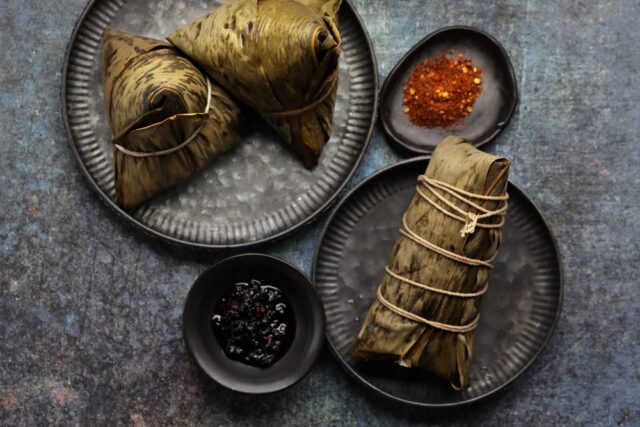COMMENTARY, May 31 — Today is the Dragon Boat Festival or Duen Ng Jit (or Double Fifth Festival in Cantonese).
The fifth day of the fifth month in the Chinese lunar calendar, when we commemorate how the ancients threw dumplings into a river where a beloved poet had drowned himself to prevent the fish from eating his corpse.
Which sounds a bit macabre but what we are most mindful of today aren’t dragon boat races or long-lamented poets but the delicious dumplings.
This is my ode to the Dragon Boat dumplings, specifically my favourite Cantonese zung.
The most common triangular or pyramid shaped ‘zung’. — Picture by CK Lim
Let us begin with its iconic shape (and the appetite-whetting thrill we get when we recognise it, even from a distance.)
The most common zung you’d see is likely to be triangular or pyramid shaped. A tetrahedron, really.
There are, of course, variations. The Northern Chinese zung is shaped like a log. In Japan, their version of zung, called chimaki, is sweet and has a long conical shape, typically eaten on Children’s Day.

A Northern Chinese ‘zung’ is shaped like a log. — Picture by CK Lim
Those who grew up Malaccan, as I did, care less about the shape and more about the colour of the zung. Our Nyonya version is partially dyed blue thanks to the use of blue pea flower; the filling is simpler too — a sweet blend of minced pork and candied winter melon.
But there’s nothing quite like the stuffing of a formidable Cantonese zung.
Full of goodness within, from shiitake mushrooms and mung beans to marinated pork belly and tender chestnuts. A bit of decadence when you add Chinese sausages and salted egg yolks. Plenty of aged umami from dried shrimp and dried scallops.
Don’t forget the sugar, salt and Chinese five spice. The secret ingredient, I’ve been told, is some chicken bouillon powder (the same secret ingredient to a fantastic fried rice, come to think of it).
It’s like the greatest hits from a well-stocked Cantonese pantry.

Full of goodness within, from mushrooms to chestnuts. — Picture by CK Lim
This might sound blasphemous to some but consider pairing your favourite savoury zung with some chilli oil. Really, don’t knock it till you’ve tried it.
Some folks like to dip their zung into a saucer of granulated sugar; me, I prefer some fragrant laat ziu yau.
My favourite chilli oil is laden with fermented soybeans for an extra umami kick. Experiment with different types of chilli oil — anything from chilli crisps with fried garlic flakes to a hot honey chilli crunch.
Honestly, it doesn’t taste as spicy as you might fear (not when you have grown up eating cili padi!). The spice doesn’t threaten unbearable heat; instead it deepens the savouriness of the zung.
Your taste buds will thank me, as will you.

Pair your favourite savoury ‘zung’ with some chilli oil. — Picture by CK Lim
Of course, if you truly crave something fiery, you can always spice things up with some Sichuan mala powder.
The mixture of Sichuan peppercorns, dried chilies, salt and a good dose of aromatic spices such as cardamom, cumin, cloves and star anise will electrify your palate.
Not too much, but just enough to make you appreciate a soothing slice of shiitake mushroom or a fatty morsel of pork belly. You might be delusional from the numbing spices but you swear these gelatinous textures help to cool your tongue, now on fire.

Spice things up with some Sichuan ‘mala’ powder. — Picture by CK Lim
At the end of the day though, I’m happy to enjoy my zung as is.
Slowly peeling the greasy bamboo leaves away to reveal the glutinous pyramid within. Slicing the now naked dumpling to unearth its treasures.
Which should I taste first? The collagen-rich pork belly? The sweet chestnut? The seductive salted egg yolk?
Perhaps start simply, with a few grains of the sticky rice, as well seasoned as a good life.










